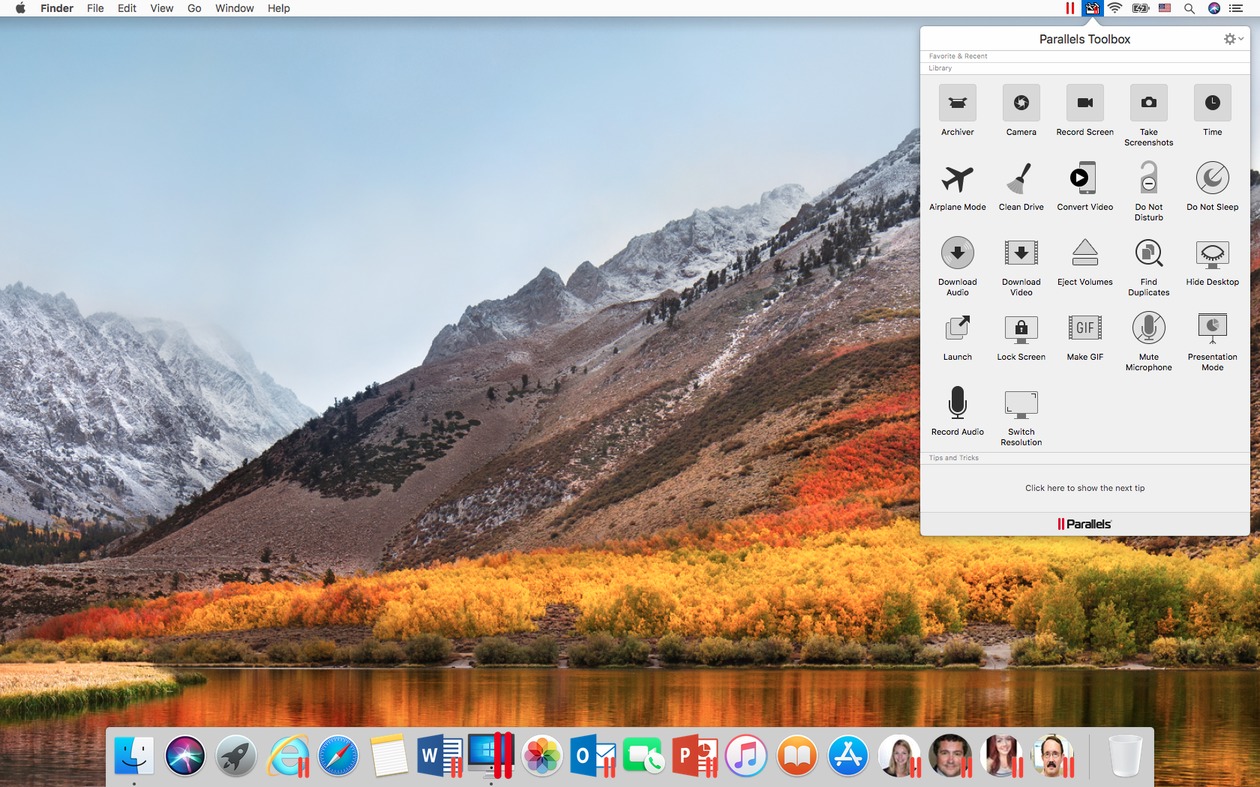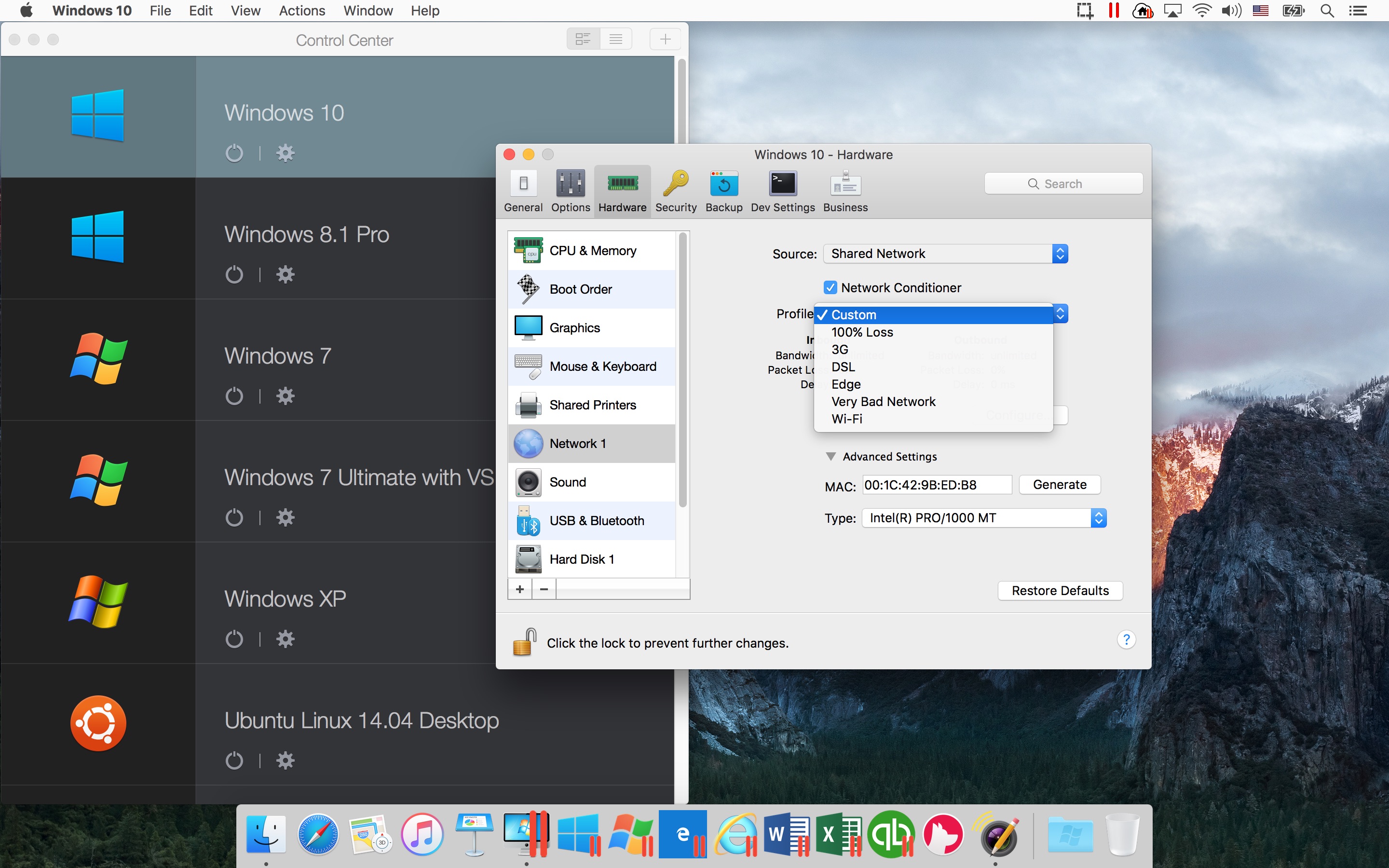Parallels Desktop 13 for Mac got its official release on Tuesday. The thirteenth version of the Windows virtualization software comes with numerous new features including support for macOS High Sierra and the Windows 10 Fall Creators Update.
Top of the features list is Touch Bar support, enabling owners of compatible MacBook Pros to use the OLED strip with Microsoft Outlook, Excel, and PowerPoint, as well as additional integration for the Windows Start Menu and Desktop, including Cortana, Task View, and Taskbar pinned elements. A Touch Bar Wizard also allows users to customize the Touch Bar and add their favorite Windows applications.
I wanted to install macOS High Sierra on a virtual machine on my Mac so that I could debug some issues. The host machine is running macOS and the guest VM would be running macOS as well. VirtualBox does not support APFS right now and neither does Parallels Lite. Optimized and ready for macOS High Sierra and the Windows 10 Creators Update, Parallels Desktop 13 for Mac allows you to run Windows 10, 8.1, and 7, as well as Linux, Google Chrome OS, and other operating systems on your Mac without rebooting.
New dynamic resolution support mean users can change the window size of their Windows session, with booting and rebooting speed said to be faster and smoother as a result. Meanwhile, enhanced support for Retina displays should see better scaling of Windows applications on Mac screens.A new Picture-in-Picture mode aims to let users monitor their virtual machine with ease, while support for the upcoming Windows 10 People Bar promises to allow users to view recent contacts in the Windows Taskbar or Mac Dock.
 More generally, Parallels claims over 47 percent faster access to Windows files and documents compared to the previous version, faster file transfers over USB 3.0 and Thunderbolt SSD devices, and up to 32 vCPU and 128GB vRAM per virtual machine with Parallels Desktop for Mac Pro Edition, with code for all new versions optimized for macOS High Sierra (10.13) and Windows 10 Fall Creators Update.
More generally, Parallels claims over 47 percent faster access to Windows files and documents compared to the previous version, faster file transfers over USB 3.0 and Thunderbolt SSD devices, and up to 32 vCPU and 128GB vRAM per virtual machine with Parallels Desktop for Mac Pro Edition, with code for all new versions optimized for macOS High Sierra (10.13) and Windows 10 Fall Creators Update. Elsewhere, Parallels claims over 30 new additional tools can be found in version 13 that simplify everyday tasks on Mac and Windows. They include a drive cleaner, video conversion, a file archiver, a GIF creator, a video downloader, Do Not Sleep and Do Not Disturb modes, a Lock Screen, and the ability to temporarily hide files on the desktop, amongst many others.
Parallels Desktop 13 for Mac costs $79.99 for a new license. Existing users of Parallels Desktop for Home and Student can upgrade to V13 for $49.99, with a time-limited offer enabling users of the Desktop Pro Edition to upgrade for the same price (usually $99.99). For more pricing details, see the Parallels website.
(Thanks, Ulric!)
Symptoms
When I start Parallels Desktop for Mac on macOS High Sierra I get the following warning:
System Extension Blocked. A program tried to load a new system extension signed by 'Parallels International GmbH' and it was blocked. If you want to enable extensions from this developer, go to the Security & Privacy System Preferences pane.
- I am trying to press 'Allow' button but nothing happens.
Cause
macOS High Sierra 10.13 introduces a new feature that requires user approval before loading newly-installed third-party kernel extensions. Third-party kernel extensions (KEXTs) that were already present when upgrading to macOS High Sierra are granted automatic approval.
This approval UI is only present in the Security & Privacy preferences pane for 30 minutes after the alert. Until the user approves the KEXT, future load attempts will cause the approval UI to reappear but will not trigger another user alert.
For more information please refer to the Apple's official tech note: Technical Note TN2459.
Moreover, it's not possible to press Allow button if a connection to Mac established remotely due to security-related configuration of macOS to block any security related actions for remote connections.
Resolution

Before performing the instructions below quit Google Chrome application using its Dock context menu > Quit if it's running now.
Open System Preferences > Security & Privacy > General > click Allow next to the corresponding message:
Parallels for mac review 2018. (I just wish this were possible while running macOS virtual machines, too.) Parallels With one option checked, Parallels Desktop 14 allows Windows 10 to take advantage of multiple displays just as elegantly as the Mac does. I really love the way PD14 handles multiple monitors in full-screen mode on Windows 10; in true Mac style, there’s no fudging around with settings, it just works.
If it's not possible to click Allow button or after clicking it nothing happens, ensure that the following recommendations are followed:
- Allow button is pressed locally. As mentioned above, due to macOS security limitations it's not possible to press Allowbutton (nothing will happen as a result of pressing it) remotely (any source of remote connection).
- No third-party input methods (keyboards, mouses, touch pads, graphics tablets) and their software are present at the moment Allow button is pressed.
Presence of third-party input methods and their software/drivers could possible cause the inability to press Allow button. Temporarily disconnect such devices from the Mac and remove their software/drivers.
It has been proven that only a presence of MagicPrefs preference pane render the Allow button unusable. Once Allow button is successfully used, macOS will store this record and it would be possible to continue using previously disconnected devices and install their software/drivers back.
Parallels 10 Mac Os High Sierra

Advanced solution
If pressing Allow button using the mouse doesn't give any positive results, use the steps described below:
- Open System Preferences > Security & Privacy > Keyboard > Shortcuts and switch Full Keyboard Access to All controls.
- Now open System Preferences > Security & Privacy > General.
- Press Tab key on the keyboard until the Allow button is highlighted, then hit Spacebaron the keyboard to press Allow button.
- Close System Preferences window and start Parallels Desktop.
Why Parallels Desktop needs its own kernel extensions?
Office for mac problems with sierra. To deliver all Parallels Desktop features, such as virtualization, USB and Network, Parallels Desktop loads the following kernel extensions to macOS:
com.parallels.kext.hypervisor - a proprietary core virtualization driver, which makes Parallels Desktop the best virtualization solution for Mac.
com.parallels.kext.vnic - Shared Network driver, which is used by a virtual router who manages all network services for a VM, such as gateway,DNS, DHCP, port forwarding, network conditioner etc.
Parallels For Mac Os X El Capitan
com.parallels.kext.usbconnect - USB driver, loaded when a USB device connects to a virtual machine (VM). Supports all USB data transfer protocols except of isochronous transfer.
Parallels Desktop 11 Mac Os High Sierra
com.parallels.kext.netbridge - Bridged Network driver, creates a virtual network adapter on Mac to connect a VM to Mac's subnet directly.